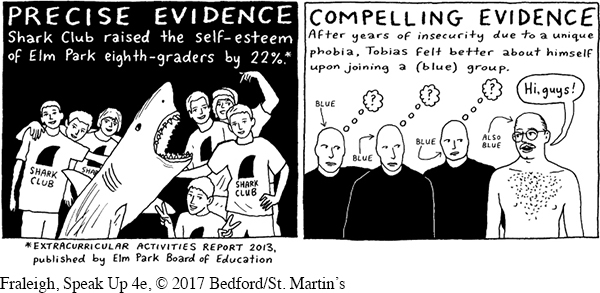Using Evidence
When your audience analysis suggests that listeners may not accept a claim you want to make, you’ll need to supply proof. One of the best ways to do so is to research evidence from credible sources (see Chapter 7) and then present that evidence in your speech. To use evidence effectively, apply the following principles.
Identify your sources and their qualifications. Indicate who your source is for each piece of evidence you present, along with her or his qualifications, before providing the evidence during your speech. Concrete documentation strengthens your credibility.5 To ensure your sources’ credibility, use facts provided by unbiased experts.6
544
Give listeners new evidence. Use audience analysis to determine what evidence is likely to be new to your listeners. Facts that they’re not yet familiar with are more likely to increase their perception of your credibility.7

Provide precise evidence. Precise evidence consists of specific dates, places, numbers, and other facts. Here’s an example of this kind of precision:
A study by Sharon Fowler and her colleagues at the University of Texas Health Science Center found that the risk of becoming obese or overweight for regular soft drink drinkers consuming one to two cans daily is 32.8 percent. For those who consume a comparable amount of diet soft drinks, the risk is 54.5 percent.8
545

This citation provides a specific percentage as well as the lead researcher’s name and affiliation.
Look for compelling evidence. Audiences are more likely to be persuaded by compelling evidence that includes concrete or detailed examples. Such evidence engages listeners’ senses, helps them visualize the point you’re presenting, and increases the likelihood that they will remember the information.9 For example, in your speech about diet sodas, you could include a compelling anecdote about a student who gained weight after switching from sugared to diet soft drinks.
546

Credible evidence documenting the significance of a problem to the audience also can be compelling. A study of public health messages found that evidence documenting the severity of a health condition to which audience members are susceptible made the message more persuasive.10
Characterize your evidence accurately. Carefully word your claim so that it accurately reflects what your evidence proves. For example, if all the facts you’ve gathered strongly support the idea that diet drinks don’t help people lose weight, then use those very words to state your claim about the drinks, rather than saying something like “Diet soft drinks aren’t as healthy as people think.”